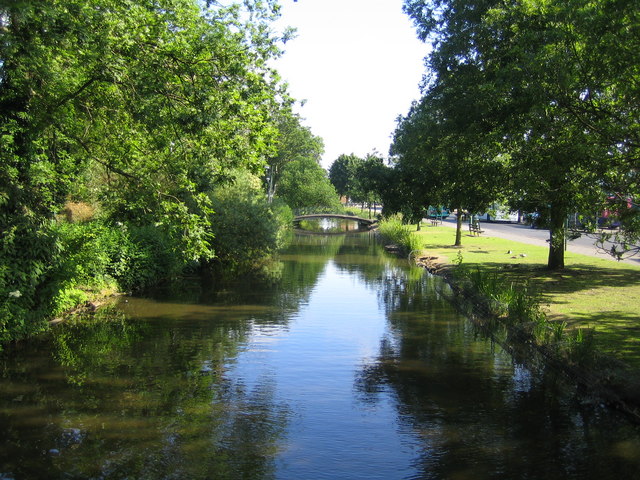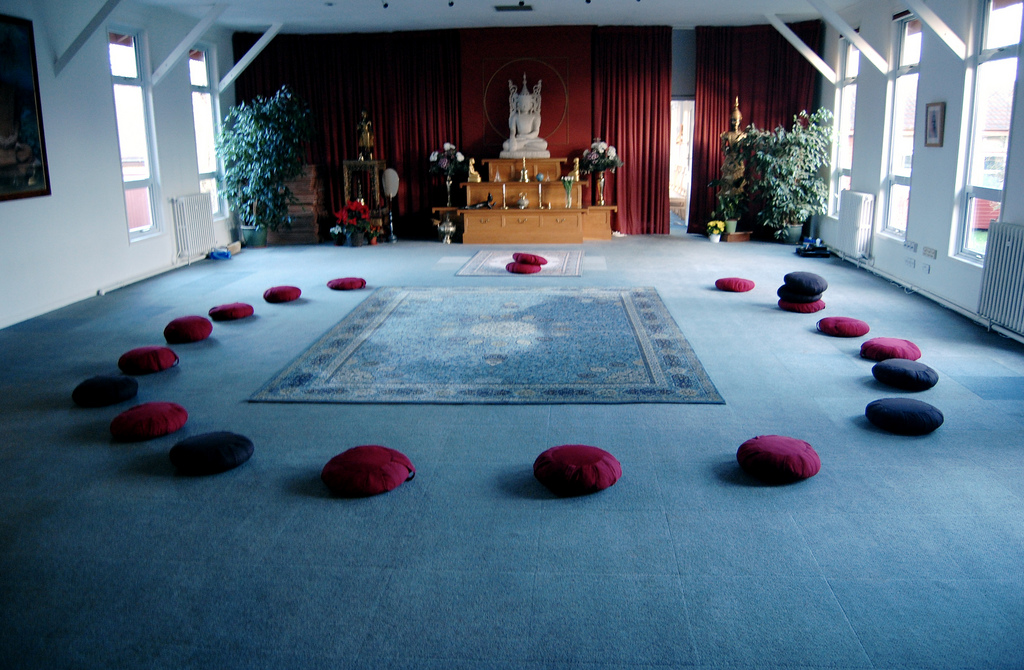|
Great Gaddesden
Great Gaddesden is a village and civil parish in Dacorum Hundred in Hertfordshire, England. It is located in the Chiltern Hills, north of Hemel Hempstead. The parish borders Flamstead, Hemel Hempstead, Nettleden and Little Gaddesden and also Studham in Bedfordshire. The Church of St. John the Baptist was probably the site of a pre-Christian sanctuary. The church shows features of every period since the 12th century. Part of the chancel with Roman bricks dates back to the early 12th century. The old church was extended by the south aisle in the 13th century and the north aisle in the 14th century, while the west tower was built in the 15th century and the north chapel in the 18th. The medieval convent of St Margaret's stood northwest of the village. For a while the site served as a WW2 Royal Canadian Air Force transit camp and later a boarding school for children with special needs, and it is now a Theravadin Buddhist monastery of Thai Forest Tradition, the Amaravati Bu ... [...More Info...] [...Related Items...] OR: [Wikipedia] [Google] [Baidu] |
Dacorum
The Borough of Dacorum is a local government district in Hertfordshire, England that includes the towns of Hemel Hempstead, Berkhamsted, Tring and Kings Langley. The district, which was formed in 1974, had a population of 137,799 in 2001. Its name was taken from the old hundred of Dacorum which covered approximately the same area. It is the westernmost of Hertfordshire's districts, being bordered to the west by the Chiltern and Aylesbury Vale districts of Buckinghamshire. History The name Dacorum comes from Latin and it means "of the Dacians" (with a " hundred" implied). The latter word was used mistakenly in the Middle Ages for 'Danes'. This happened because of a legend asserting that certain tribes from Dacia had migrated to Denmark. The hundred of Dacorum was first recorded in 1196, although it has existed since the 9th and 10th centuries, when it lay near the southern boundary of the Danelaw, on the River Lea. In 1086, the Domesday Book records the hundreds of Tri ... [...More Info...] [...Related Items...] OR: [Wikipedia] [Google] [Baidu] |
World War II
World War II or the Second World War, often abbreviated as WWII or WW2, was a world war that lasted from 1939 to 1945. It involved the vast majority of the world's countries—including all of the great powers—forming two opposing military alliances: the Allies and the Axis powers. World War II was a total war that directly involved more than 100 million personnel from more than 30 countries. The major participants in the war threw their entire economic, industrial, and scientific capabilities behind the war effort, blurring the distinction between civilian and military resources. Aircraft played a major role in the conflict, enabling the strategic bombing of population centres and deploying the only two nuclear weapons ever used in war. World War II was by far the deadliest conflict in human history; it resulted in 70 to 85 million fatalities, mostly among civilians. Tens of millions died due to genocides (including the Holocaust), starvation, massa ... [...More Info...] [...Related Items...] OR: [Wikipedia] [Google] [Baidu] |
Watercress
Watercress or yellowcress (''Nasturtium officinale'') is a species of aquatic flowering plant in the cabbage family Brassicaceae. Watercress is a rapidly growing perennial plant native to Europe and Asia. It is one of the oldest known leaf vegetables consumed by humans. Watercress and many of its relatives, such as garden cress, mustard, radish, and wasabi, are noteworthy for their piquant flavors. The hollow stems of watercress float in water. The leaf structure is pinnately compound. Small, white, and green inflorescences are produced in clusters and are frequently visited by insects, especially hoverflies, such as ''Eristalis'' flies. Taxonomy Watercress is listed in some sources as belonging to the genus '' Rorippa'', although molecular evidence shows those aquatic species with hollow stems are more closely related to ''Cardamine'' than ''Rorippa''. Despite the Latin name, watercress is not particularly closely related to the flowers popularly known as nasturtiums (' ... [...More Info...] [...Related Items...] OR: [Wikipedia] [Google] [Baidu] |
River Gade
The River Gade is a river running almost entirely through Hertfordshire. It rises from a spring in the chalk of the Chiltern Hills at Dagnall, Buckinghamshire and flows through Hemel Hempstead, Kings Langley, then along the west side of Watford through Cassiobury Park. After passing Croxley Green it reaches Rickmansworth, where it joins the River Colne. For its whole course the Gade is unnavigable. Its principal tributary is the River Bulbourne which joins it at Two Waters, just below Hemel Hempstead. The river was once used to power water mills, such as those at Water End, Cassiobury Park and Two Waters as well as powering the John Dickinson paper mills at Apsley and Croxley. It supported the farming of watercress at Cassiobury Park, Water End, the Grade 2 listeJellicoe Water Gardensand Two Waters until water was diverted from the river in 1947 to supply the growing new town of Hemel Hempstead. Below Hemel Hempstead it runs alongside and sometimes forms part of the G ... [...More Info...] [...Related Items...] OR: [Wikipedia] [Google] [Baidu] |
Gaddesden Place
Gaddesden Place, near Hemel Hempstead in Hertfordshire, England, was designed by architect James Wyatt and built between 1768 and 1773, and was the home of the Hertfordshire Halsey family. The house is set in an elevated position overlooking the Gade Valley and is said to enjoy one of the finest views in the Home Counties. History The Halseys moved to Great Gaddesden in 1458 and later became lessees of the Rectory of Gaddesden until 12 March 1545. When King Henry VIII dissolved the monasteries during the Reformation, he granted the estate of King's Langley Priory to William Hawes (or Halsey, also Chambers). The Halsey family residence was at the Golden Parsonage, a sixteenth-century mansion situated in Gaddesden Row. Thomas Halsey (1731–1788) MP erected a new mansion, Gaddesden Place, to Wyatt's design, about a mile south-west of the Golden Parsonage. In 1774 the family moved to Gaddesden Place, and the Golden Parsonage was partially demolished. In 1788, Thomas Halse ... [...More Info...] [...Related Items...] OR: [Wikipedia] [Google] [Baidu] |
Amaravati Buddhist Monastery
Amaravati is a Theravada Buddhist monastery at the eastern end of the Chiltern Hills in South East England. Established in 1984 by Ajahn Sumedho as an extension of Chithurst Buddhist Monastery, the monastery has its roots in the Thai Forest Tradition. It takes inspiration from the teachings of the community's founder, the late Ajahn Chah. Its chief priorities are the training and support of a resident monastic community, and the facilitation for monastic and lay people alike of the practice of the Buddha's teachings. It is not to be confused with the ancient Amaravati Stupa in India. Community The resident community consists of monks (bhikkhus), nuns ( siladhara), and male and female postulants who live in accordance with strict traditional codes of celibacy, together with a volunteer support staff and visitors. According to the monastery website, regarding the male monastic community, "Usually, there are between 15 and 25 bhikkhus and samaneras in residence, living a co ... [...More Info...] [...Related Items...] OR: [Wikipedia] [Google] [Baidu] |
Thai Forest Tradition
The Kammaṭṭhāna Forest Tradition of Thailand (from pi, kammaṭṭhāna meaning "place of work"), commonly known in the West as the Thai Forest Tradition, is a lineage of Theravada Buddhist monasticism. The Thai Forest Tradition started around 1900 with Ajahn Mun Bhuridatto, who wanted to practice Buddhist monasticism, and its meditative practices, according to the normative standards of pre-sectarian Buddhism. After studying with Ajahn Sao Kantasīlo and wandering through the north-east of Thailand, Ajahn Mun reportedly became a non-returner and started to teach in North-East Thailand. He strived for a revival of the Early Buddhism, insisting on a strict observance of the Buddhist monastic code, known as the Vinaya, and teaching the practice of '' jhāna'' and the realisation of ''nibbāna''. Initially, Ajahn Mun's teachings were met with fierce opposition, but in the 1930s his group was acknowledged as a formal faction of Thai Buddhism, and in the 1950s the rel ... [...More Info...] [...Related Items...] OR: [Wikipedia] [Google] [Baidu] |
Theravada
''Theravāda'' () ( si, ථේරවාදය, my, ထေရဝါဒ, th, เถรวาท, km, ថេរវាទ, lo, ເຖຣະວາດ, pi, , ) is the most commonly accepted name of Buddhism's oldest existing school. The school's adherents, termed Theravādins, have preserved their version of Gautama Buddha's teaching or '' Buddha Dhamma'' in the Pāli Canon for over two millennia. The Pāli Canon is the most complete Buddhist canon surviving in a classical Indian language, Pāli, which serves as the school's sacred language and ''lingua franca''.Crosby, Kate (2013), ''Theravada Buddhism: Continuity, Diversity, and Identity'', p. 2. In contrast to ''Mahāyāna'' and ''Vajrayāna'', Theravāda tends to be conservative in matters of doctrine (''pariyatti'') and monastic discipline (''vinaya''). One element of this conservatism is the fact that Theravāda rejects the authenticity of the Mahayana sutras (which appeared c. 1st century BCE onwards). Modern Theravāda ... [...More Info...] [...Related Items...] OR: [Wikipedia] [Google] [Baidu] |
Royal Canadian Air Force
The Royal Canadian Air Force (RCAF; french: Aviation royale canadienne, ARC) is the air and space force of Canada. Its role is to "provide the Canadian Forces with relevant, responsive and effective airpower". The RCAF is one of three environmental commands within the unified Canadian Armed Forces. As of 2020, the Royal Canadian Air Force consists of 12,074 Regular Force and 1,969 Primary Reserve personnel, supported by 1,518 civilians, and operates 258 manned aircraft and nine unmanned aerial vehicles. Lieutenant-General Eric Kenny is the current commander of the Royal Canadian Air Force and chief of the Air Force Staff. The Royal Canadian Air Force is responsible for all aircraft operations of the Canadian Forces, enforcing the security of Canada's airspace and providing aircraft to support the missions of the Royal Canadian Navy and the Canadian Army. The RCAF is a partner with the United States Air Force in protecting continental airspace under the North American Aerospac ... [...More Info...] [...Related Items...] OR: [Wikipedia] [Google] [Baidu] |
St Margaret's Convent Hertfordshire
St Margaret's Convent was a convent of the Benedictine order near Great Gaddesden in Hertfordshire, England. Founded in 1160, it was abolished as a consequence of King Henry VIII's dissolution of the monasteries in the 1530s.Topography of Buckinghamshire: comprising a general survey of the county, preceded by an epitome of the early history of Great Britain Author James Joseph Sheahan Publisher Longman, Green, Longman, and Roberts, 1862 St Margarets entry Pages 700-701- It was also known as The Priory of Ivinghoe, St. Margaret's, ... [...More Info...] [...Related Items...] OR: [Wikipedia] [Google] [Baidu] |
Hertfordshire
Hertfordshire ( or ; often abbreviated Herts) is one of the home counties in southern England. It borders Bedfordshire and Cambridgeshire to the north, Essex to the east, Greater London to the south, and Buckinghamshire to the west. For government statistical purposes, it forms part of the East of England region. Hertfordshire covers . It derives its name – via the name of the county town of Hertford – from a hart (stag) and a ford, as represented on the county's coat of arms and on the flag. Hertfordshire County Council is based in Hertford, once the main market town and the current county town. The largest settlement is Watford. Since 1903 Letchworth has served as the prototype garden city; Stevenage became the first town to expand under post-war Britain's New Towns Act of 1946. In 2013 Hertfordshire had a population of about 1,140,700, with Hemel Hempstead, Stevenage, Watford and St Albans (the county's only ''city'') each having between 50,000 and 10 ... [...More Info...] [...Related Items...] OR: [Wikipedia] [Google] [Baidu] |
Studham
Studham is a village and civil parish in the county of Bedfordshire. It has a population of 1,128. The parish bounds to the south of the Buckinghamshire border, and to the east is the Hertfordshire border. The village lies in the wooded south facing dip slope of the Chiltern Hills. The hamlet of Holywell is located to the north of Studham, and forms part of the same civil parish. In the Domesday Book of 1086 it was recorded as ''Estodham''. Studham's church celebrated its millennium in 1997. The ancient parish of Studham straddled the Bedfordshire/Hertfordshire border. It also had a detached part known as Humbershoe which lay to the east of the rest of the parish, which contained the north-western part of the village of Markyate. Humbershoe became a separate civil parish in 1866, and was separated from the ecclesiastical parish of Studham in October 1877 when it was included in the new ecclesiastical parish of St John Markyate Street. In December 1894, under the Local Gover ... [...More Info...] [...Related Items...] OR: [Wikipedia] [Google] [Baidu] |






